Shyam Saran travels to the ruined Jordanian city that was once a cosmopolitan hub controlling main global trade routes.
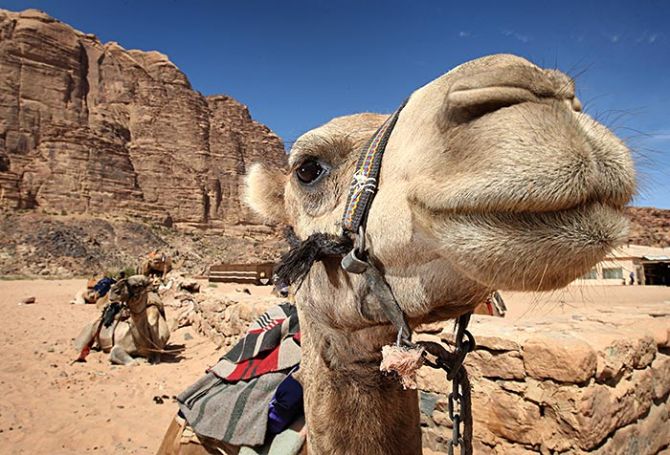
Petra built during the fifth and sixth centuries BC, is the ruined capital of the Nabatean Arabs.
The sandstone in the region has given rise to unique rock formations, rising from the desert, forming deep canyons and fissures.
Also read: The desert that resembles Mars!
Photograph: Chris Jackson/Getty Images.
That the iconic film, Lawrence of Arabia, and the popular adventure classic, Indiana Jones and the Last Crusade, were both shot at locations in Jordan should tell you something about a country where history lurks at every turn amidst its deserts, hills and valleys.
A recent visit took me to its capital, Amman, better known as 'Philadelphia' in Roman times, to the even more ancient capital of the Nabataean kingdom, Petra, and finally the beige, rust and grey desert landscape of Wadi Rum.
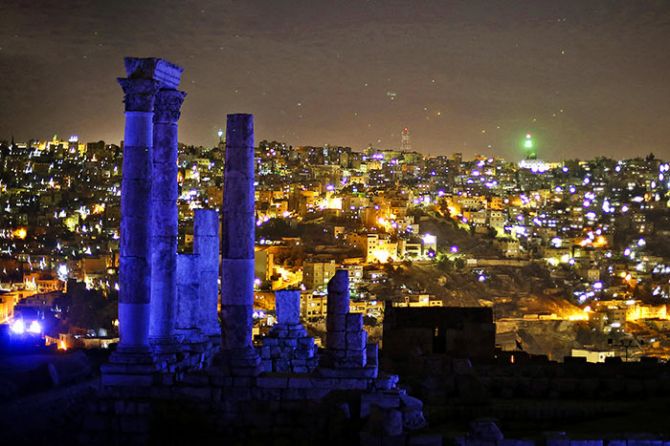
Also read: My Amman diary
Photograph: Muhammad Hamed/Reuters.
Amman was originally a city spread along seven hills, its modern name derived from Rabbath Ammon or the great city of the Ammonite people mentioned in the Old Testament.
It was later a Roman city, and the Amman citadel contains the ruins of an ancient temple of Hercules, the remains of a later Byzantine church and a somewhat incongruous governor's palace from the 8th century Umayyad period, unmistakably Saracenic in form.
Just outside the ruins of the temple is an enormous marble fist and also part of an elbow, all that remains of what must have been a massive statue of Hercules at this site.
In the small museum nearby is a Byzantine mosaic with a figure of perhaps a monk in a robe with the motif of the swastika pointing to contacts with ancient India.
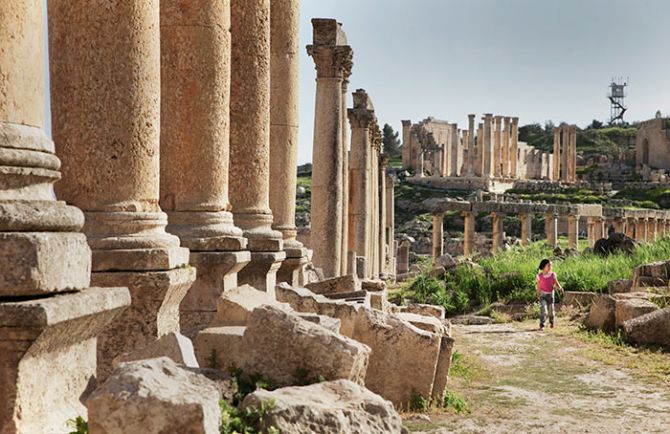
Photograph: Adam Pretty/Getty Images.
The Amman citadel was connected along an ancient Roman road to the much more impressive and better preserved Greco-Roman city of Jerash about two hours' drive towards the north.
The entry to the city is through Hadrian's Gate, constructed in 129 AD to welcome the Roman emperor, Hadrian, on his visit to the city.
The sprawling settlement has well-preserved ruins of temples to the Greek god, Zeus, and to the goddess Artemis.
There is a huge colonnaded Oval Forum that served as the city centre.
At one corner near the temple to Artemis is an exquisite and compact amphitheatre, obviously used for theatrical performances and cultural events.
But what is most impressive is a long street with Corinthian columns, on either side of which there had once been shops selling goods from the far-flung corners of a Roman empire at its zenith. The cobblestones that line the street still carry the indentations made by the chariots and carts that passed on it over several centuries.
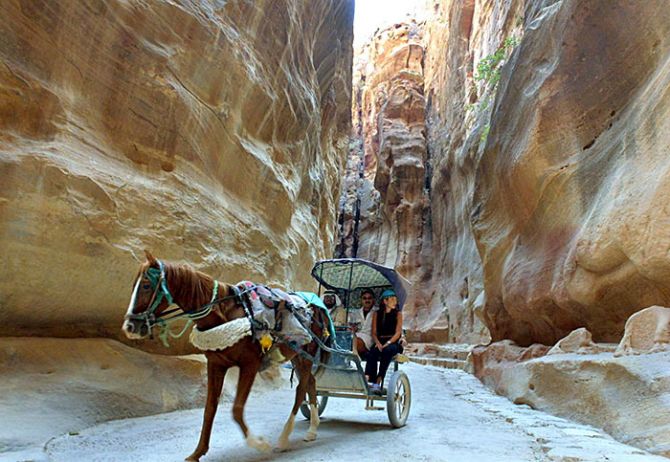
This ancient city was literally sculpted out of the pink and red sandstone cliffs, its monumental structures a testament to the architectural and engineering skills of the Nabatean people who ruled this desert kingdom from about 300 BC to the 2nd century AD.
Photograph: Suhaib Salem/Reuters.
The visit to Petra was undoubtedly the high point of my journey.
This ancient city was literally sculpted out of the pink and red sandstone cliffs, its monumental structures a testament to the architectural and engineering skills of the Nabatean people who ruled this desert kingdom from about 300 BC to the 2nd century AD.
The entry to the city is through a narrow canyon, called the Al Siq in Arabic, or 'the secret way'.
Nothing quite prepares a visitor for the arresting vision of the most exquisite Greco-Roman mausoleum, the Al-Khazneh or 'The Treasury', as the narrow corridor suddenly opens out to a wide courtyard. This is only the first of a series of red sandstone structures all carved out of solid sandstone and merging seamlessly with the surrounding landscape.
Most of the buildings are tombs but there are others that are remains of palaces and villas of rich citizens.
There is a vast amphitheatre carved entirely out of rock.
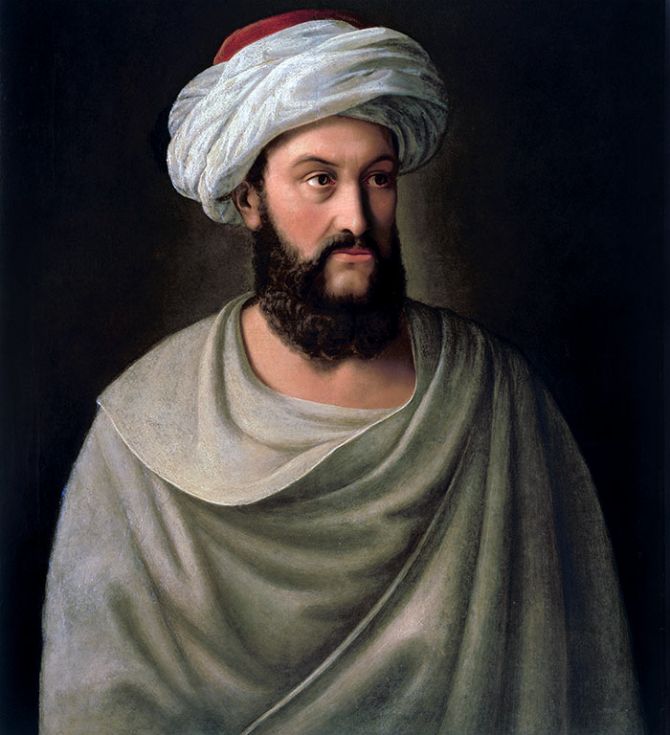
In order to gain access to the site, the Swiss traveller and scholar took on the identity of an Indian trader, Sheikh Ibrahim bin Abdallah.
His grave in Cairo carries his Indian name.
Photograph: Basel Historical Museum/Wikimedia Commons.
The Nabateans grew rich from the ancient caravan trade that linked the far-flung cities of the Greek, Persian and Roman empires. These caravans carried frankincense and myrrh from southern Arabia and Africa, spices, gems and cotton cloth from India, and silk from China. And Petra, at its height, controlled the main trade routes and served as an exchange hub for the precious commodities that were being traded.
Petra was a cosmopolitan city, its architecture reflecting styles borrowed from Greece and Rome but also from nearby Assyria. Most of the buildings carry a trademark motif on their lintels depicting steps on either side. This is often found on old Assyrian monuments.
There are also buildings with the head of the elephant as a decorative motif and this demonstrates familiarity with India.
What is most impressive about Petra is its water storage and distribution system, testifying to the mastery of hydraulic engineering of the Nabateans that can still teach a lesson or two to our water-scarce planet.
The city's water supply came from three major springs on its periphery as also a series of dams built in the folds of the canyons to catch and store rain water. The water from the springs was brought through a series of aqueducts, or water pipes, made out of terracotta and lined with ceramic tiles using gravity to ensure a constant flow. One can still see the remains of these water channels along the canyon walls while approaching Petra as also several of the over 200 cistern tanks to store water. The total capacity of the system has been estimated at 40 million litres per day, enough to sustain a population of 100,000. But Petra had a maximum resident population of 30,000, although there must have been a larger floating population of traders and visitors.
The ancient geographer, Strabo, had written about Petra's famous gardens, water pools and fountains in the 1st century BC.
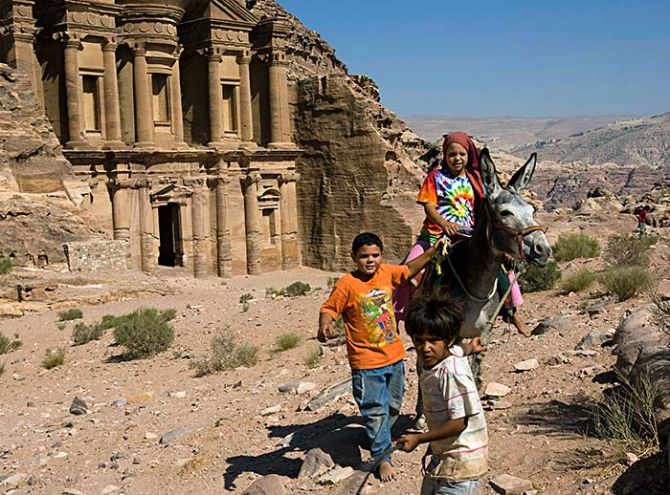
Over time, the Bedouin tribes reclaimed the desert and became the sentinels of these lost cities.
Photograph: Steve Crisp/Reuters.
Besides the elephant heads, Petra also has another Indian connection.
The ruins of the city were first discovered by a Swiss traveller and scholar, Johann Ludwig Burckhardt, in 1821.
Burckhardt had lived for several years in Syria where he heard stories of a lost city in the desert. In order to gain access to the site, he took on the identity of an Indian trader, Sheikh Ibrahim bin Abdallah, and embarked on a pilgrimage to the tomb of Aaron, a companion of the Prophet, which lies at one corner of Petra.
He kept this assumed identity till his death in Cairo a few years later. His grave carries his Indian name.
Petra became part of the Roman empire in the 2nd century but continued to flourish as a commercial settlement.
Its decline began as new and safer trade routes across the seas emerged, enabling larger cargoes to traverse vast distances. Over time the Bedouin tribes reclaimed the desert and became the sentinels of these lost cities.
Shyam Saran is a former foreign secretary and currently senior fellow at Centre for Policy Research.










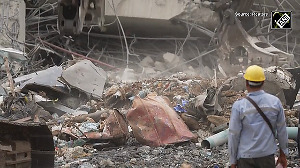

 © 2025
© 2025